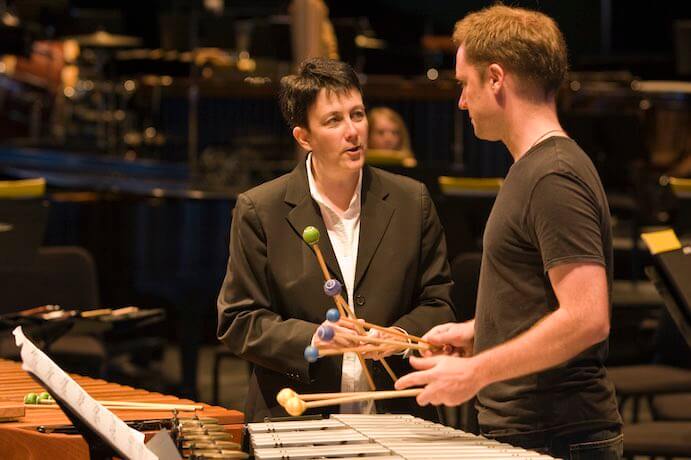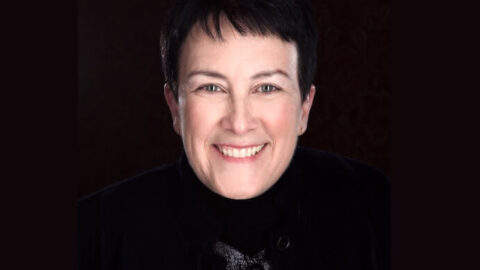Jennifer Higdon has just added a new concerto to her catalog — Duo Duel, for two percussionists and orchestra. Jointly commissioned by the Houston Symphony, Cabrillo Festival of Contemporary Music, and the University of Miami’s Frost School of Music, and written for Houston Symphony percussionists Svet Stoyanov and Matthew Strauss, the 24-minute Duo Duel will premiere in-person and online on May 6-8, with the Houston Symphony. Higdon’s previous concertos have become pillars of contemporary classical music. She is the 2010 winner of the Pulitzer Prize for music for her Violin Concerto. We caught up with Jennifer to learn more about her upcoming premiere and her composition process.
Were there any trademarks of Svet Stoyanov and Matthew Strauss’ performance style or previously-performed repertoire that you worked into Duo Duel?
Svet and Matthew both have such extraordinary technique and musicality that I decided that I should focus on speed (virtuosity) and beauty (which is a word that one does not always think about when thinking about percussion). And while these two gentlemen certainly don’t have a monopoly on these characteristics, they definitely both have such extraordinary technique and musicianship that it’s worth exploiting these qualities as much as possible. I can remember watching Svet play my Percussion Concerto and being impressed by the high speed of his execution of my music… and without breaking a sweat. Writing this new work, I wondered to myself, Can he go even faster? You’ll have to come to the concerts to see for yourself!

You’ve noted that you composed the work so that the percussionists are in a constant conversation/dialogue with each other. Can you talk about how you constructed these musical conversations and how they help to create the architecture of the work?
When a composer is faced with writing any kind of percussion feature, unique choices have to be made (which aren’t necessary for any other type of concerto): How many different instruments should I write for (there are hundreds of possibilities)? Should they be pitched and/or non-pitched? How many instruments can I array at the front of the stage? And how much room do the percussionists need to move about (which is a big question when there is an orchestra backing you)?
Starting this piece around the time that the world was shutting down, I found that my choices were colored by the fact that we were being closed off from the actual physical presence of people. I felt my soul yearning for the personal interactions that we are so able to express in music, but also achieve in a live performance. I decided immediately that I wanted melody to be the primary focus, so therefore I chose only pitched percussion instruments (vibes, marimba, crotales, and six timpani). The soloists constantly have melodic interactions that vary between delicate, magical dances, to complex high-speed races, with notes flying everywhere.
Looking back on the writing of this piece, I can actually sense my deep feeling of needing to reach out to other people… The piece reflects the need for communication, but also the joy one experiences when hearing soloists blasting away in joy! Watching percussionists perform is also fun because the audience gets to really see the physical demands, both with arms and mallets going, but also the quick shifts between instruments. Between mallet changes and instrument changes, everything has to be completely calculated in the composing process to guarantee that it is doable.
Can you tell us about how this piece fits into the rest of your oeuvre: are there any nods in the work to your Grammy-winning Percussion Concerto, or does the work have any “close siblings” among your other pieces?
This is a good question for a musicologist. Because I don’t ever sit around thinking about any of my pieces in relation to the other works, I don’t feel like I have any thoughts as to which works would be close siblings to this concerto. I tend to approach each commission differently, according to the personality of the performers for whom I’m writing. I think one thing that I learned from my Percussion Concerto is that percussionists love to play and they can play so fast and with such power, but also with real delicacy (which audiences don’t always get to experience with percussion).
I do remember talking with Svet and Matthew about the fact that percussionists often feel they don’t have a concerto with the melodic equivalence (and musical seriousness) of a violin concerto. That comment made me shift my thinking about what I might want to emphasize in this percussion feature, as opposed to my first percussion concerto. This brought up the question of should I approach the composing differently if melody is the top priority — and I discovered that yes, I needed to think about the process differently.
I found that my choices were colored by the fact that we were being closed off from the actual physical presence of people. I felt my soul yearning for the personal interactions that we are able to express in music.
Concerto-writing is an exciting, daunting task for a composer. Do you have a story you could share with us about writing your first concerto?
Duo Duel is my 15th concerto, which is a lot of concerti for one composer, but when you get enthusiastic soloists who really want a work, it’s hard to say no. I guess my first concerto was actually a little different from my other concerti, because it was my Concerto for Orchestra. It was commissioned by the Philadelphia Orchestra, and it was cool how the performers, when they heard I was writing a concerto for the orchestra itself, made individual requests for solos. I was appreciative because I was seriously terrified of how huge the commission was (30 minutes and for the hometown band), and any suggestions were certainly welcomed. It was a formative step in terms of the piece, because I decided that I should have a movement that focused primarily on solos for the principal players; that movement constitutes the heart of the piece, and it was easier to think (at the start) about writing solos, as opposed to having the think immediately of writing for the entire orchestra at the beginning.
So I began the actual writing with that third movement… It felt a little like using training wheels before getting the keys to the bigger, faster race car. That concerto was a life-changer for me. Composers don’t usually get a single concert when a piece is premiered in front of a massive crowd which has the ability to change your life (the premiere was at the League of American Orchestras Conference — so a ton of administrators and conductors were in the audience). It was truly one of the most terrifying concerts I’ve sat through (in fact, I was so nervous I stayed backstage); but I could not have asked for a better result… I started getting offers for commissions the very next morning. And that commission’s success led to the Philadelphia Orchestra coming back soon after and asking if I’d be interested in writing my Percussion Concerto.
The Percussion Concerto has a really funny story to it. The work premiered with the Philadelphia Orchestra the day after Thanksgiving in 2005. So the soloist, Colin Currie flew to the U.S. from his home in London, and we had two days of rehearsal before Thanksgiving. I didn’t want Colin to have to eat room service on Thanksgiving Day, so we invited him over. We had a lot of family in town for the premiere, and I was concerned that the turkey had been sitting out too long. I didn’t want my soloist to get sick from food poisoning, because if he went down the piece wouldn’t be performed. So I talked my better half (aka Cheryl) into doing a taste test to check it. When she didn’t get sick, I agreed to let Colin have turkey. We all had a good laugh over this, stuffed ourselves silly, and then sent our intrepid percussion soloist off with a huge piece of pumpkin pie to Verizon Hall to practice on the cadenza that he would be performing the following night.

Inquiring minds want to know: how do you celebrate after you’ve finished a piece?
You’re going to laugh when you read this, but I was truly startled when I saw this question. I haven’t ever thought to celebrate after finishing a piece! Since I do my own copy work (people think I’m insane for doing this, but it helps me find problems in the music), I am usually working on parts as I begin the next piece. I do move literally right to the next piece as soon as I’m finished with a work. So I tend not to have breaks between pieces. But Cheryl reminded me (as I was writing this) that I did, in fact go out and have a huge, fancy dinner after finishing my first opera. Maybe I should make that more of a tradition.
I CARE IF YOU LISTEN is an editorially-independent program of the American Composers Forum, funded with generous donor and institutional support. Opinions expressed are solely those of the author and may not represent the views of ICIYL or ACF.
A gift to ACF helps support the work of ICIYL. For more on ACF, visit the “At ACF” section or composersforum.org.
























